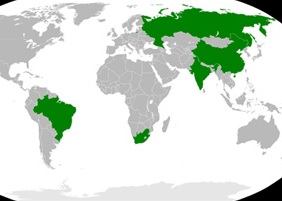
In view of the present and future requirements of global tuberculosis control, a sustained fight against tuberculosis now needs enhanced investment.
Meetings of health ministers from the five BRICS countries (Brazil, Russia, India, China, and South Africa) have produced two joint statements in less than a year: the Delhi Communiqué (1) (Jan 12, 2013) and the Cape Town Communiqué (2) (Nov 7, 2013). Both statements bode well for global tuberculosis control. The Delhi Communiqué underscores the principle of equity and focuses on populations who are most affected by the disease. The Cape Town Communiqué emphasises promotion of consortia of researchers to collaborate for clinical trials of drugs and vaccines, strengthening of access to affordable, high-quality, effective, and safe medicines, and delivery of high-quality health care. These approaches are in agreement with the overall approach of tuberculosis elimination strategies, which foster innovation within well managed systems and through bold policies (eg, for infection control, rational drug use, and mandatory case notification) (3).
With decreases in incidence and mortality, progress in tuberculosis control has been evident (4). However, several challenges persist, including tackling of multidrug-resistant tuberculosis (which has emerged because of widespread access and use of tuberculosis drugs over the past decades), and replacement of old, inadequate methods for diagnosis, treatment, and prevention with new, rapid methods. Changes in the global political economy also call for adjustments to financing of global tuberculosis control. Half of the high-tuberculosis-incidence countries that were classified as low income in 2000 are now in the middle-income category, and more are expected to join this group by 2020 (figure). The five BRICS countries, which account for 25% of global gross domestic product, 30% of global land area, and 45% of the world's population, also bear about 45% of the world's burden of tuberculosis and more than 60% of the burden of multidrug-resistant tuberculosis (4, 5). This finding is not surprising; four-fifths of people who survive on less than US$2 a day are estimated to live in middle-income countries (6). BRICS and other middle-income countries with a large burden of tuberculosis should also have the resources to tackle the disease. The global response to tuberculosis needs to be rebalanced.
In view of the present and future requirements of global tuberculosis control, a sustained fight against tuberculosis now needs enhanced investments on at least three fronts. First, continued international financing is necessary to further support the lowest-income countries in sub-Saharan Africa and elsewhere with necessary resources and technical assistance (7); a handful of fragile states need special attention and full support. Second, the BRICS and other middle-income countries should continue to enhance domestic health investments, while benefiting from nuanced international financing during a transition period towards full self-reliance in tuberculosis care and prevention. Third, far larger investments (including from BRICS countries) are needed to boost research, development, and introduction of new drugs, diagnostics, and vaccines, without which tuberculosis elimination cannot be achieved (8).
The two statements from the BRICS partnership could help to inform how best emerging economies can contribute to achievement of ambitious global targets for tuberculosis control. BRICS and other economies in transition have a great responsibility and the potential to contribute to all aspects of care, prevention, and research for tuberculosis. Middle-income countries will need to enhance investments in social protection, including universal health coverage, to ensure prompt diagnosis of tuberculosis and completion of treatment. As the economies of these countries further improve, more countries will join this front, leaving fewer in need of substantial external assistance (figure). Countries of the Organisation for Economic Co-operation and Development and international financing mechanisms (eg, the Global Fund to fight AIDS, Tuberculosis, and Malaria) should coordinate their efforts and adjust aid flows towards the lowest-income countries and fragile states while leveraging domestic resources in the BRICS and other emerging economies to address equity and support vulnerable populations in the lowest-income quintile.
In the new era of a globalised world and growing importance of global public goods, the economic transition in health calls for rebalancing of health development aid, international cooperation, and scientific leadership. Collective, coordinated, and country-led responses for a healthier world are the appropriate and responsible way forward. In this endeavour, the importance of country ownership with local advocacy and capacity, and international technical assistance and cooperation, cannot be overstressed.
We declare that we have no conflicts of interest. We thank Philippe Glaziou for providing the figure. MR and MU are staff members of WHO. The authors alone are responsible for the views expressed in this Comment; they do not necessarily represent the decisions or the policies of WHO.
References
1 . http://www.pib.nic.in/newsite/erelease.aspx?relid=91533. (accessed Sept 20, 2013).
2 . http://www.brics5.co.za/3rd-health-ministers-meeting-south-africa-7th-november-2013-cape-town-communique/. (accessed Jan 6, 2014).
3 . Scaling up interventions to achieve global tuberculosis control: progress and new developments. Lancet 2012; 379: 1902-1913. Summary | Full Text | PDF(532KB) | CrossRef | PubMed
4 . Global TB Report 2013. Geneva: World Health Organization, 2013.
5 . http://www.brics.utoronto.ca/newsdesk/delhi/lavrov.html. (accessed Jan 6, 2014).
6 . Where will the world's poor live? Global poverty projections for 2020 and 2030. IDS In Focus policy briefing 26. Brighton: Institute of Development Studies, 2012.
7 . Domestic and donor financing for tuberculosis care and control in low and middle-income countries: an analysis of trends, 2002—11, and requirements to meet 2015 targets. Lancet Glob Health 2013; 1: e105-e115. PubMed
8 . Setting new targets in the fight against tuberculosis. Nat Med 2013; 19: 263. CrossRef | PubMed
Mario Raviglione a, Mukund Uplekar a, Cheri Vincent b, Ariel Pablos-Méndez b
a Global TB Programme, World Health Organization, Geneva, Switzerland
b United States Agency for International Development, Washington, DC, USA
Source: The Lancet Global Health